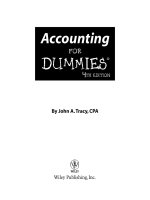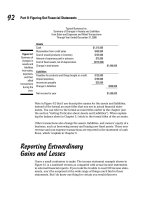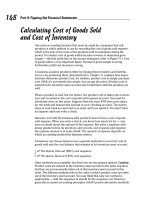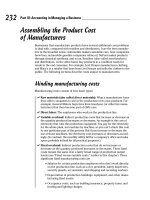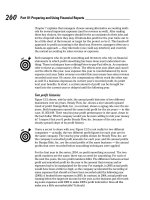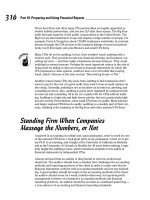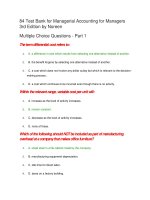Managerial accounting for dummies
Bạn đang xem bản rút gọn của tài liệu. Xem và tải ngay bản đầy đủ của tài liệu tại đây (7.77 MB, 268 trang )
Managerial Accounting For Dummies®
Published by
John Wiley & Sons, Inc.
111 River St.
Hoboken, NJ 07030-5774
www.wiley.com
Copyright © 2013 by John Wiley & Sons, Inc., Hoboken, New Jersey
Published simultaneously in Canada
No part of this publication may be reproduced, stored in a retrieval system or transmitted in any
form or by any means, electronic, mechanical, photocopying, recording, scanning or otherwise,
except as permitted under Sections 107 or 108 of the 1976 United States Copyright Act, without
the prior written permission of the Publisher. Requests to the Publisher for permission should be
addressed to the Permissions Department, John Wiley & Sons, Inc., 111 River Street, Hoboken,
NJ 07030, (201) 748-6011, fax (201) 748-6008, or online at
/>Trademarks: Wiley, the Wiley logo, For Dummies, the Dummies Man logo, A Reference for the
Rest of Us!, The Dummies Way, Dummies Daily, The Fun and Easy Way, Dummies.com, Making
Everything Easier, and related trade dress are trademarks or registered trademarks of John Wiley
& Sons, Inc., and/or its affiliates in the United States and other countries, and may not be used
without written permission. All other trademarks are the property of their respective owners. John
Wiley & Sons, Inc., is not associated with any product or vendor mentioned in this book.
Limit of Liability/Disclaimer of Warranty: The publisher and the author make no
representations or warranties with respect to the accuracy or completeness of the contents
of this work and specifically disclaim all warranties, including without limitation warranties
of fitness for a particular purpose. No warranty may be created or extended by sales or
promotional materials. The advice and strategies contained herein may not be suitable for
every situation. This work is sold with the understanding that the publisher is not engaged in
rendering legal, accounting, or other professional services. If professional assistance is
required, the services of a competent professional person should be sought. Neither the
publisher nor the author shall be liable for damages arising herefrom. The fact that an
organization or Website is referred to in this work as a citation and/or a potential source of
further information does not mean that the author or the publisher endorses the information
the organization or Website may provide or recommendations it may make. Further,
readers should be aware that Internet Websites listed in this work may have changed or
disappeared between when this work was written and when it is read.
For general information on our other products and services, please contact our Customer Care
Department within the U.S. at 877-762-2974, outside the U.S. at 317-572-3993, or fax 317-572-
4002.
For technical support, please visit www.wiley.com/techsupport.
Wiley publishes in a variety of print and electronic formats and by print-on-demand. Some
material included with standard print versions of this book may not be included in e-books or in
print-on-demand. If this book refers to media such as a CD or DVD that is not included in the
version you purchased, you may download this material at . For
more information about Wiley products, visit www.wiley.com.
Library of Congress Control Number: 2012955830
ISBN 978-1-118-11642-5 (pbk); ISBN 978-1-118-22442-7 (ebk); ISBN 978-1-118-23764-9
(ebk); ISBN 978-1-118-26255-9 (ebk)
Manufactured in the United States of America
10 9 8 7 6 5 4 3 2 1
About the Author
Mark Holtzman is chair of the Department of Accounting and Taxation at Seton Hall University
in South Orange, New Jersey. After earning his bachelor’s degree in Accounting from Hofstra
University in Hempstead, Long Island, New York, he joined the New York office of Touche Ross
& Co., now part of the accounting firm Deloitte. After attaining certification as a CPA and
reaching the level of Senior Auditor, Mark joined the Accounting PhD program at The University
of Texas at Austin, where he authored his doctoral dissertation on earnings management in the oil
and gas industry. After completing his PhD, Mark joined the accounting faculty at Hofstra
University and subsequently moved to Seton Hall, where he teaches financial accounting and
managerial accounting courses to both graduate and undergraduate students.
In addition to authoring articles and other research materials in the CPA Journal, Journal of
Accountancy, Accounting Historians Journal, Research in Accounting Regulation, Financial
Executive, Strategic Finance, the Corporate Controller’s Manual, and Bank Accounting and
Finance, Mark is coauthor of Interpreting and Analyzing Financial Statements with Karen
Schoenebeck, now in its 6th edition (Pearson).
Always enthusiastic and eager to share his irreverent and irrelevant opinions, Mark regularly
blogs as the accountinator (www.accountinator.com), freaking accountant
(www.freakingaccountant.com), and freaking important (www.freakingimportant.com). His
Twitter handle is @accountinator.
In his spare time, Mark enjoys spending time with his family, hiking, camping, and studying ancient
Hebrew texts.
Dedication
To my family: Rikki, who stoically endures living with a curmudgeon accounting professor, and
my astonishing kids, Dovid, Aharon, Levi, and Esther.
Author’s Acknowledgments
I would like to thank all of the wonderfully dedicated professionals at Wiley who helped make
this book a reality in spite of my best attempts to the contrary. My acquisitions editor, Stacy
Kennedy, called me out of the blue, asking if I would be interested in writing this. My project
editor, Elizabeth Rea, has been wonderfully tolerant of my fickle approach to meeting deadlines.
She was especially patient when I went camping instead of finishing the second quarter, and she
didn’t complain one bit when I missed the final deadline and then subsequently decided to
rearrange the table of contents.
I’d also like to thank my copy editor, Megan Knoll, who somehow managed to translate my
resourceful approach to capitalization, italics, commas, hyphenation, quotation marks, and clever
profanity into clear English.
Technical editors John Zullo and Steve Markoff painstakingly combed through the manuscripts and
offered thoughtful suggestions to make this book clear, accurate, and precise. I am especially
grateful to them for identifying certain absent-minded omissions of the word not.
Thank you, too, to my colleagues and students at Seton Hall. It is a privilege and joy to learn and
work with you.
Publisher’s Acknowledgments
We’re proud of this book; please send us your comments at . For other
comments, please contact our Customer Care Department within the U.S. at 877-762-2974, outside
the U.S. at 317-572-3993, or fax 317-572-4002.
Some of the people who helped bring this book to market include the following:
Acquisitions, Editorial, and Vertical Websites
Project Editor: Elizabeth Rea
Acquisitions Editor: Stacy Kennedy
Copy Editor: Megan Knoll
Assistant Editor: David Lutton
Editorial Program Coordinator: Joe Niesen
Technical Editors: Steven R. Markoff, CMA, CPA, CGMA; John J. Zullo, CPA
Editorial Manager: Michelle Hacker
Editorial Assistant: Alexa Koschier
Cover Photos: © iStockphoto.com/Rob Friedman
Cartoons: Rich Tennant (www.the5thwave.com)
Composition Services
Project Coordinator: Patrick Redmond
Layout and Graphics: Joyce Haughey, Andrea Hornberger, Jennifer Mayberry
Proofreader: Tricia Liebig
Indexer: Sharon Shock
Publishing and Editorial for Consumer Dummies
Kathleen Nebenhaus, Vice President and Executive Publisher
David Palmer, Associate Publisher
Kristin Ferguson-Wagstaffe, Product Development Director
Publishing for Technology Dummies
Andy Cummings, Vice President and Publisher
Composition Services
Debbie Stailey, Director of Composition Services
Managerial Accounting For Dummies®
Visit
www.dummies.com/cheatsheet/managerialaccou
to view this book's cheat sheet.
Table of Contents
Introduction
About This Book
What You’re Not to Read
Foolish Assumptions
How This Book Is Organized
Part I: Introducing Managerial Accounting
Part II: Understanding and Managing Costs
Part III: Using Costing Techniques for Decision-Making
Part IV: Planning and Budgeting
Part V: Using Managerial Accounting for Evaluation and Control
Part VI: The Part of Tens
Icons Used in This Book
Where to Go from Here
Part I: Introducing Managerial Accounting
Chapter 1: The Role of Managerial Accounting
Checking Out What Managerial Accountants Do
Analyzing costs
Planning and budgeting
Evaluating and controlling operations
Reporting information needed for decisions
Understanding Costs
Defining costs
Predicting cost behavior
Driving overhead
Costing jobs and processes
Distinguishing relevant costs from irrelevant costs
Accounting for the Future: Planning and Budgeting
Analyzing contribution margin
Budgeting capital for assets
Choosing what to sell
Pricing goods
Setting up a master budget
Flexing your budget
Evaluating and Controlling Operations
Allocating responsibility
Analyzing variances
Producing a cycle of continuous improvement
Distinguishing Managerial from Financial Accounting
Becoming a Certified Professional
Following the code of ethics
Becoming a certified management accountant
Becoming a chartered global management accountant
Chapter 2: Using Managerial Accounting in Your Business
What Business Are You In? Classifying Companies by Their Output
Checking out service companies
Perusing retailers
Looking at manufacturers
Measuring Profits
Earning revenues
Computing cost of sales
Incurring operating expenses
Measuring net income
Scoring return on sales
Considering Efficiency and Productivity
Distinguishing between efficiency and productivity
Measuring asset turnover
Putting Profitability and Productivity Together: Return on Assets
Part II: Understanding and Managing Costs
Chapter 3: Classifying Costs
Distinguishing Direct from Indirect Manufacturing Costs
Costing direct materials and direct labor
Understanding indirect costs and overhead
Assessing Conversion Costs
Telling the Difference between Product and Period Costs
Searching for Incremental Costs
Accounting for Opportunity Costs
Ignoring Sunk Costs
Chapter 4: Figuring Cost of Goods Manufactured and Sold
Tracking Inventory Flow
Dealing with direct materials
Investigating work-in-process inventory
Getting a handle on finished goods
Cracking cost of goods sold
Calculating Inventory Flow
Computing direct materials put into production
Determining cost of goods manufactured
Computing cost of goods sold
Preparing a Schedule of Cost of Goods Manufactured
Chapter 5: Teaching Costs to Behave: Variable and Fixed Costs
Predicting How Costs Behave
Recognizing how cost drivers affect variable costs
Remembering that fixed costs don’t change
Separating Mixed Costs into Variable and Fixed Components
Analyzing accounts
Scattergraphing
Using the high-low method
Fitting a regression
Sticking to the Relevant Range
Chapter 6: Allocating Overhead
Distributing Overhead through Direct Labor Costing
Calculating overhead allocation
Experimenting with direct labor costing
Applying over- and underestimated overhead to cost of goods sold
Taking Advantage of Activity-Based Costing for Overhead Allocation
Applying the four steps of activity-based costing
Finishing up the ABC example
Chapter 7: Job Order Costing: Having It Your Way
Keeping Records in a Job Order Cost System
Getting the records in order
Allocating overhead
Completing the job order cost sheet
Understanding the Accounting for Job Order Costing
Purchasing raw materials
Paying for direct labor
Paying for overhead
Requisitioning raw materials
Utilizing direct labor
Applying overhead
Chapter 8: Process Costing: Get In Line
Comparing Process Costing and Job Order Costing
Keeping Process Costing Books
Debiting and crediting
Keeping track of costs
Moving units through your factory — and through the books
Demonstrating Process Costing
Buying raw materials
Paying for direct labor
Incurring overhead
Moving raw materials into production
Using direct labor
Allocating overhead
Moving goods through the departments
Preparing a Cost of Production Report
Part 1: Units to account for
Part 2: Units accounted for
Part 3: Costs to account for
Part 4: Costs accounted for
Part III: Using Costing Techniques for Decision-Making
Chapter 9: Straight to the Bottom Line: Examining Contribution Margin
Computing Contribution Margin
Figuring total contribution margin
Calculating contribution margin per unit
Working out contribution margin ratio
Preparing a Cost-Volume-Profit Analysis
Drafting a cost-volume-profit graph
Trying out the total contribution margin formula
Practicing the contribution margin per unit formula
Eyeing the contribution margin ratio formula
Generating a Break-Even Analysis
Drawing a graph to find the break-even point
Employing the formula approach
Shooting for Target Profit
Observing Margin of Safety
Using a graph to depict margin of safety
Making use of formulas
Taking Advantage of Operating Leverage
Graphing operating leverage
Looking at the operating leverage formula
Chapter 10: Capital Budgeting: Should You Buy That?
Identifying Incremental and Opportunity Costs
Keeping It Simple: The Cash Payback Method
Using the cash payback method with equal annual net cash flows
Using the cash payback method when annual net cash flows change each year
It’s All in the Timing: The Net Present Value (NPV) Method
Calculating time value of money with one payment for one year
Finding time value of money with one payment held for two periods or more
Calculating NPV with a series of future cash flows
Measuring Internal Rate of Return (IRR)
Considering Nonquantitative Factors
Chapter 11: Reality Check: Making and Selling More than One Product
Preparing a Break-Even Analysis with More than One Product
Step 1: Computing contribution margin ratio
Step 2: Estimating sales mix
Step 3: Calculating weighted average contribution margin ratio
Step 4: Getting to break-even point
Coping with Limited Capacity
Deciding When to Outsource Products
Eliminating Unprofitable Products
Chapter 12: The Price Is Right: Knowing How Much to Charge
Differentiating Products
Taking All Costs into Account with Absorption Costing
Pricing at Cost-Plus
Computing fixed markups
Setting a cost-plus percentage
Considering problems with cost-plus pricing
Extreme Accounting: Trying Variable-Cost Pricing
Working out variable-cost pricing
Avoiding the hazards of variable-cost pricing
Bull’s-Eye: Hitting Your Target Cost
Calculating your target cost
Knowing when to use target costing
Chapter 13: Spreading the Wealth with Transfer Prices
Pinpointing the Importance of Transfer Pricing
Negotiating a Transfer Price
Finding the selling division’s minimum transfer price
Setting the purchasing division’s maximum transfer price
Trying to meet in the middle
Managing with full capacity
Transferring Goods between Divisions at Cost
Setting the transfer price at variable cost
Establishing the transfer price at variable cost plus a markup
Basing transfer price on full cost
Positioning Transfer Price at Market Value
Part IV: Planning and Budgeting
Chapter 14: Master Budgets: Planning for the Future
Preparing a Manufacturer’s Master Budget
Obtaining a sales budget
Generating a production budget
Setting a direct materials budget
Working on a direct labor budget
Building an overhead budget
Adding up the product cost
Fashioning a selling and administrative budget
Creating a cash budget
Constructing a budgeted income statement
Applying Master Budgeting to Nonmanufacturers
Budgeting a retailer
Coordinating a service company’s budget
Chapter 15: Flexing Your Budget: When Plans Change
Controlling Your Business
Dealing with Budget Variances
Implementing a Flexible Budget
Separating fixed and variable costs
Comparing the flexible budget to actual results
Part V: Using Managerial Accounting for Evaluation and Control
Chapter 16: Responsibility Accounting
Linking Strategy with an Organization’s Structure
Decentralizing
Distinguishing controllable costs from noncontrollable costs
Identifying Different Kinds of Centers
Revenue centers
Cost centers
Profit centers
Investment centers
Chapter 17: Variance Analysis: To Tell the Truth
Setting Up Standard Costs
Establishing direct materials standards
Determining direct labor standards
Determining the overhead rate
Adding up standard cost per unit
Understanding Variances
Computing direct materials variances
Calculating direct labor variances
Overhead any good variances lately?
Teasing Out Variances
Interpreting variances in action
Focusing on the big numbers
Tracing little numbers back to big problems
Chapter 18: The Balanced Scorecard: Reviewing Your Business’s Report Card
Strategizing for Success: Introducing the Balanced Scorecard
Making money: The financial perspective
Ensuring your clients are happy: The customer perspective
Keeping the clock ticking: The internal business perspective
Can your workforce handle it? The learning and growth perspective
Measuring the immeasurable
Demonstrating the Balanced Scorecard
Sketching a strategy that incorporates all four perspectives
Identifying measures for the balanced scorecard
Chapter 19: Using the Theory of Constraints to Squeeze Out of a Tight Spot
Understanding Constraints
Manufacturing constraints
Service constraints
Managing Processes with the Theory of Constraints
Step 1: Identifying system constraints
Step 2: Exploiting the constraint
Step 3: Subordinating everything to the constraint
Step 4: Breaking the constraint
Step 5: Returning to Step 1
Part VI: The Part of Tens
Chapter 20: Ten Key Managerial Accounting Formulas
The Accounting Equation
Net Income
Cost of Goods Sold
Contribution Margin
Cost-Volume-Profit Analysis
Break-Even Analysis
Price Variance
Quantity Variance
Future Value
Present Value
Chapter 21: Ten Careers in Managerial Accounting
Corporate Treasurer
Chief Financial Officer
Corporate Controller
Accounting Manager
Financial Analyst
Cost Accountant
Budget Analyst
Internal Auditor
Fixed-Assets Accountant
Cash-Management Accountant
Chapter 22: Ten Legends of Managerial Accounting
Dan Bricklin
Cynthia Cooper
Sergio Cicero Zapata
Eliyahu Goldratt
Ernest Hauser
Robert Kaplan
Harry Markopoulos
Paul Sarbanes and Michael Oxley
David Stockman
Sherron Watkins
Cheat Sheet
Introduction
If accounting is the language of business, then managerial accounting is the language inside a
business. Accountants establish very specific definitions for terms such as revenue, expense, net
income, assets, and liabilities. Everyone uses these same definitions when they announce and
discuss these attributes, so that when a company reports sales revenue, for example, investors and
other businesspeople understand how that figure was calculated. This way, companies, investors,
managers, and everyone else in the business community speak the same language, a language for
which accountants wrote the dictionary.
Managerial accounting allows a company’s managers to understand how their business operates
and gives them information needed to make decisions. It helps them plan their business’s activities
and control its operations. For example, suppose a marketing executive needs to set a price for a
new product. To set that price, the executive needs to understand how much the product costs;
that’s where managerial accounting comes in. Furthermore, the price needs to be set at such a level
that at the end of the year, when the company sells all the products it’s supposed to sell at
whatever prices it sets, it earns the profit and cash flow that it has projected for itself. That, too, is
where managerial accounting comes in.
When I teach managerial accounting, I always take care to point out who the users of managerial
accounting information usually are. They’re the managers, marketing professionals, financial
analysts, and information systems professionals working within a company. All have a role not
only in developing managerial accounting information but also, more importantly, in using it to
make better decisions.
About This Book
If managerial accounting is the language inside a business, then running a business without
understanding that topic would be pretty hard. Therefore, I wrote this book for businesspeople —
both present and future — who want to better understand how to use managerial accounting to
make decisions and how managerial accountants actually develop information.
That said, I have a confession to make: Much to the dismay of my wife and the embarrassment of
my children, I really love to do accounting, especially managerial accounting. And better yet, I
love to teach it. I believe that contribution margin is the greatest thing since sliced bread (see
Chapter 9) and that the theory of constraints can solve most of life’s problems (see Chapter 19).
And I often think about and admire the legends of managerial accounting that I introduce in Chapter
22.
For all the bad rap that accounting gets for being boring (and for all that financial accountants, of
all people, trash their poor managerial brethren for being the most boring of all accountants), I felt
a special calling to commit to writing — and share with you — what I believe makes managerial
accounting engaging and (yes) exciting, right here in this book.
Therefore, when you start reading this book and soon find that you can’t put it down, don’t blame
me and my lame little puns. Instead, appreciate that after you start discovering accounting, it can
be quite difficult to stop.
What You’re Not to Read
I tried to write this book so that it spellbinds you, the reader, such that you feel you can’t put it
down until you read the whole thing. Others may be tempted to peak at the last few pages to see
how it ends.
That said, if you’re very busy, feel free to focus on the most important stuff that you need to know
and skip some of these less important elements:
Technical stuff: Anything marked with the Technical Stuff icon is especially interesting to
managerial accounting geeks like me. However, if you’re in a rush, you can skip these
paragraphs.
Sidebars: These fascinating little gray-shaded boxes include factoids and information that I
thought you may like, but you can pick up managerial accounting just fine without reading them.
Foolish Assumptions
To write this book, I had to make certain assumptions about you. I assume that you’re one of the
following people:
A college student taking a managerial accounting course who needs some help understanding
the topics you’re covering in class
A businessperson or entrepreneur who wants to know more about how to collect accounting
information to make decisions
A recent college graduate interested in pursuing a career in managerial accounting, perhaps as
a certified management accountant
A professional accountant or bookkeeper looking for a straightforward refresher in the basics
of managerial accounting
How This Book Is Organized
Each of the six parts of this book tackles a different aspect of managerial accounting. The
following sections explain how I organized the information so that you can find what you need
quickly and easily.
Part I: Introducing Managerial Accounting
Part I gives you a basic taste of what managerial accounting is and why it’s important. It also
reviews some important aspects of accounting that every businessperson needs to know. I hit
profitability, efficiency, productivity, and continuous improvement especially hard.
Part II: Understanding and Managing Costs
At its very crux, managerial accounting is all about costs — be they direct, indirect, overhead, or
whatever — and how those costs behave. What drives costs up, down, or sideways? Part II
explores the world of costs.
Part III: Using Costing Techniques for Decision-Making
When you understand how costs work, you’re ready to make decisions, and that’s what Part III
deals with. After a brief spiel about my favorite topic — contribution margin — I explain about
how to use cost information to make decisions. I cover such areas as whether to buy equipment,
which products to make, and how to price.
Part IV: Planning and Budgeting
An important part of managing an organization is planning for the future, and managerial
accountants play a critical role in this process by preparing budgets, the topic of Part IV. These
budgets integrate information from every part of an organization to develop a plan to meet
managers’ goals. To make things even more interesting, I explain how managers can flex their
budgets — prepare budgets that can adapt to changing facts and circumstances.
Part V: Using Managerial Accounting for Evaluation and Control
Accountants have a reputation for being control freaks, but it’s part of the job. Managers and
managerial accountants not only plan but also need to control. This duty means that they carefully
monitor a company’s performance and compare that performance to their budgets. That way,
managers can quickly identify and address problems before the problems become crises. Part V
explains how to evaluate and control the activities throughout an organization, including using
responsibility accounting, variance analysis, and two techniques managers utilize to run their
companies: the balanced scorecard and the theory of constraints.
Part VI: The Part of Tens
The chapters in this part provide you with a quick reference to the most important formulas in the
book. I also share some career options for managerial accountants and profile inspirational role
models.
Icons Used in This Book
Throughout the margins of this book, certain symbols emphasize important points, examples, and
warnings. Watch for these icons:
This icon highlights facts that are especially important to keep in mind. Tucking these facts
away helps you keep key concepts at your fingertips.
This icon pops up alongside examples that show you how to apply an idea to real-life
accounting problems.
Like building the Titanic II, not every idea is a good idea. This icon alerts you to
situations that require caution. Look out!
This icon marks simple hints that can help you solve problems on tests and in real-life
managerial accounting situations.
I couldn’t resist sharing these interesting tidbits with you. However, if you’re in a hurry,
don’t panic; just skip them.
Where to Go from Here
All the chapters in this book are modular, so you can study and understand them without reading
other chapters. Just go through the table of contents and pick out a topic that you want to know
more about. I provide cross-references to topics in other chapters where appropriate, so if you’ve
skipped a foundational concept crucial to what you’re reading about, you know where to find what
you need.
If you’re looking to discover managerial accounting from scratch, or to unlearn some part of
managerial accounting that you fear you learned wrong, start with Part I to get the basics. When
writing this book, I took special care to explain all the fundamentals that some managerial
accounting texts skip. Students with little or no background in accounting should make a point to
read Chapter 2.
Managerial accounting itself is built on a few basic principles. In my experience, most students
who have trouble learning managerial accounting usually improve their performance after
becoming more familiar with these basic principles. Therefore, to better understand these
foundations, take a look at Chapter 3 (basic cost principles), Chapter 5 (cost behavior), and
Chapter 9 (contribution margin).
If you’re studying for a college exam, make sure you know the relevant key formulas in
Chapter 20.
Part I
Introducing Managerial Accounting
In this part . . .
Part I gives a brief overview of all topics in managerial accounting. I first explain what
managerial accountants do, why they do it, and what you can do to become a managerial
accountant. Then I give you some background about business and management to help you
understand managerial accounting, including how different kinds of companies operate; how
accountants measure profits, efficiency, and productivity; and how managers apply continuous
improvement.
